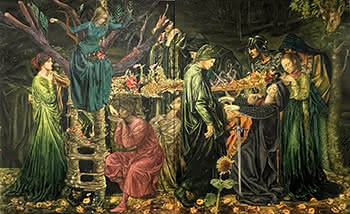Large Yellow Green Diptych
184.5 x 300 cm
est. $120,000 - 140,000
 Relative size
Relative size
PROVENANCE Private Collection, Auckland Acquired from Robert Heald Gallery, Wellington
EXHIBITED Andrew McLeod: New oil paintings, Robert Heald Gallery, Wellington, 23 April - 15 May 2015
Andrew McLeod's huge diptych, painted in 2015, offers something rather unusual in this day and age - a meticulously rendered faux-medieval scene within a forest at night, but brightly lit so as to render visible every detail of feature and clothing of the richly gowned figures (women and men) and the flowers, swords, sculpted dragons and animals with which the scene is liberally populated. What on earth (or out of it) are we viewing? An apt description of the painting is captured in words by Edward Burne-Jones (1833-98), the English pre-Raphaelite painter, one of the probable sources of McLeod's picture. He once wrote: I mean by a picture a beautiful romantic dream, of something that never was, never will be - in a light better than any that ever shone - in a land no-one can define or remember, only desire - and the forms divinely beautiful. Every phrase of this comment is relevant to this extraordinary picture.
McLeod, whose career now stretches over about twenty-five years, has never been easy to pin down because his practice is so eclectic and wide-ranging, including paintings, prints, digital images and artist's books. Even within painting he operates freely across boundaries which many artists choose not to transgress such as that between abstraction and figuration. Nevertheless, pictures such as this which resemble in some ways the 'costume dramas' of theatre, movies or television are recurrent in his practice. McLeod is very much an artist of our time in inhabiting an image-saturated world in which the whole panoply of visual culture from cave drawings to the latest computer-generated images is simultaneously available to him for plunder and usage. He is very knowledgeable about art history and once told an interviewer that the most important aspect of his art education was the Elam art school library (since sadly destroyed) which he consumed avidly book by book and shelf by shelf.
In ransacking art history McLeod is often drawn to currently unfashionable periods and styles, such as nineteenth century British academic painting (Alma-Tadema, Leighton etc.) and the Victorian pre-Raphaelite movement in particular. A specialist could no doubt identify sources for some if not all of the figures in the diptych in works by Dante Gabriel Rossetti, John Everett Millais, Edward Burne-Jones or other members of the 'brotherhood'. This practice of copying from prior paintings should not be confused with vulgar plagiarism but is more akin to musical 'sampling', a practice wide-spread in hip-hop and other contemporary music. I suspect the visual sources here also include various Renaissance models. For example, the facial profiles of the dozen or so figures in the diptych are reminiscent of the chiselled profiles in Giotto's frescoes.
Each panel of the diptych depicts a commanding sumptuously green-gowned figure (female on the left, male on the right), whom other elaborately costumed figures venerate (one perched in a tree with flowers in her lap, another with arms outstretched garbed and veiled in black) in attitudes of ceremonial adoration, prayer, obeisance, supplication and the like. Two figures are transected by the division between the panels making the image continuous across the division. This unity is also enhanced by an ambiguous horizontal structure in mid-picture on which lilies and other items are scattered as if on an animal pelt. Various individual objects - an animal head in the top right corner, a sunflower in bloom, a hovering sword - are prominent though to what precise end, beyond contributing to the romantic quasi-Arthurian atmosphere, is anybody's guess. Pre-Raphaelitism embodied a medievalising nostalgia implicitly designed to efface the horrors of industrial England; McLeod's antipodean post- modern channelling of the movement is a further exhilarating escape into the aesthetics of pure style.
PETER SIMPSON




